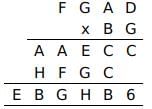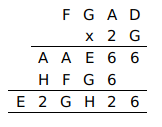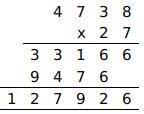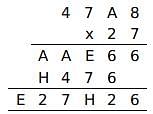CAT Exam > CAT Questions > In the above multiplication, A, B, C, D, E, F...
Start Learning for Free

In the above multiplication, A, B, C, D, E, F, G and H are the different digits of number such that none of them is divisible by 5.
If it is known that D is twice that of F, answer the following questions
Q. Which digit corresponds to the alphabet "G"?
Enter -1 if the answer can't be determined.
Correct answer is '7'. Can you explain this answer?
Most Upvoted Answer
In the above multiplication, A, B, C, D, E, F, G and H are the differe...
Since none of the digits is divisible by 5, Digits can be 1,2,3,4,6,7,8 and 9 only.
From the above we see that C + 0 = 6. Thus C = 6.
Looking at the second digit of the product. Unit place of C + C = B. Thus unit digit of 6+6(12) is 2. Thus B = 2.
The product simplifies into

We observe that unit places of D × G = 6 The pair of digits which gives 6 at unit digits on their product are (1,6), (2,3), (2,8), (4,4), (4,9) (6,6) and (7,8). Since we already know that C = 6, B = 2 and D ≠ G only remaining possible pairs are (4,9) and (7,8).
Thus (D,G) can be (4,9) or (9,4) or (7,8) or (8,7)
Upon further observation, we see that FGAD × 2 = HFG6 which is a 4-digit number. Thus the maximum possible value of F = 4 (if F≥5 then the product will be at least 5- digit. Thus F = 1 or 3 or 4
We are given that D=2×F Thus F = 4, D= 8 which leaves G =7

The remaining alphabets are A, E and H. The remaining digits to be allocated are 1,3 and 9.
Since one of the numbers for the product is 27. Thus the final product E27H26 should be divisible by 27. Thus it should be divisible by 9 also. For a number to be divisible by 9, the sum of its digits has to be a multiple of 9
Thus E+2+7+H+2+6 = 9k or E + H = 9k−17 or E + H = 9k′ + 1 where k = k′+2
Thus E + H = 1 or 10
E + H = 1 is not possible as both are positive digts. Thus E + H = 10 and it happens when (E,H) = (1,9) or (9,1). Thus it will mean that A = 3 is the only possible scenario. Now we know that the 2 numbers whose product is taken is 4738 and 27. We can input the values and get the following

Thus we obtain the following allocation

Community Answer
In the above multiplication, A, B, C, D, E, F, G and H are the differe...
Since none of the digits is divisible by 5, Digits can be 1,2,3,4,6,7,8 and 9 only.
From the above we see that C + 0 = 6. Thus C = 6.
Looking at the second digit of the product. Unit place of C + C = B. Thus unit digit of 6+6(12) is 2. Thus B = 2.
The product simplifies into

We observe that unit places of D × G = 6 The pair of digits which gives 6 at unit digits on their product are (1,6), (2,3), (2,8), (4,4), (4,9) (6,6) and (7,8). Since we already know that C = 6, B = 2 and D ≠ G only remaining possible pairs are (4,9) and (7,8).
Thus (D,G) can be (4,9) or (9,4) or (7,8) or (8,7)
Upon further observation, we see that FGAD × 2 = HFG6 which is a 4-digit number. Thus the maximum possible value of F = 4 (if F≥5 then the product will be at least 5- digit. Thus F = 1 or 3 or 4
We are given that D=2×F Thus F = 4, D= 8 which leaves G =7

The remaining alphabets are A, E and H. The remaining digits to be allocated are 1,3 and 9.
Since one of the numbers for the product is 27. Thus the final product E27H26 should be divisible by 27. Thus it should be divisible by 9 also. For a number to be divisible by 9, the sum of its digits has to be a multiple of 9
Thus E+2+7+H+2+6 = 9k or E + H = 9k−17 or E + H = 9k′ + 1 where k = k′+2
Thus E + H = 1 or 10
E + H = 1 is not possible as both are positive digts. Thus E + H = 10 and it happens when (E,H) = (1,9) or (9,1). Thus it will mean that A = 3 is the only possible scenario. Now we know that the 2 numbers whose product is taken is 4738 and 27. We can input the values and get the following

Thus we obtain the following allocation


|
Explore Courses for CAT exam
|

|
Similar CAT Doubts
In the above multiplication, A, B, C, D, E, F, G and H are the different digits of number such that none of them is divisible by 5.If it is known that D is twice that of F, answer the following questionsQ. Which digit corresponds to the alphabet "G"?Enter -1 if the answer cant be determined.Correct answer is '7'. Can you explain this answer?
Question Description
In the above multiplication, A, B, C, D, E, F, G and H are the different digits of number such that none of them is divisible by 5.If it is known that D is twice that of F, answer the following questionsQ. Which digit corresponds to the alphabet "G"?Enter -1 if the answer cant be determined.Correct answer is '7'. Can you explain this answer? for CAT 2025 is part of CAT preparation. The Question and answers have been prepared according to the CAT exam syllabus. Information about In the above multiplication, A, B, C, D, E, F, G and H are the different digits of number such that none of them is divisible by 5.If it is known that D is twice that of F, answer the following questionsQ. Which digit corresponds to the alphabet "G"?Enter -1 if the answer cant be determined.Correct answer is '7'. Can you explain this answer? covers all topics & solutions for CAT 2025 Exam. Find important definitions, questions, meanings, examples, exercises and tests below for In the above multiplication, A, B, C, D, E, F, G and H are the different digits of number such that none of them is divisible by 5.If it is known that D is twice that of F, answer the following questionsQ. Which digit corresponds to the alphabet "G"?Enter -1 if the answer cant be determined.Correct answer is '7'. Can you explain this answer?.
In the above multiplication, A, B, C, D, E, F, G and H are the different digits of number such that none of them is divisible by 5.If it is known that D is twice that of F, answer the following questionsQ. Which digit corresponds to the alphabet "G"?Enter -1 if the answer cant be determined.Correct answer is '7'. Can you explain this answer? for CAT 2025 is part of CAT preparation. The Question and answers have been prepared according to the CAT exam syllabus. Information about In the above multiplication, A, B, C, D, E, F, G and H are the different digits of number such that none of them is divisible by 5.If it is known that D is twice that of F, answer the following questionsQ. Which digit corresponds to the alphabet "G"?Enter -1 if the answer cant be determined.Correct answer is '7'. Can you explain this answer? covers all topics & solutions for CAT 2025 Exam. Find important definitions, questions, meanings, examples, exercises and tests below for In the above multiplication, A, B, C, D, E, F, G and H are the different digits of number such that none of them is divisible by 5.If it is known that D is twice that of F, answer the following questionsQ. Which digit corresponds to the alphabet "G"?Enter -1 if the answer cant be determined.Correct answer is '7'. Can you explain this answer?.
Solutions for In the above multiplication, A, B, C, D, E, F, G and H are the different digits of number such that none of them is divisible by 5.If it is known that D is twice that of F, answer the following questionsQ. Which digit corresponds to the alphabet "G"?Enter -1 if the answer cant be determined.Correct answer is '7'. Can you explain this answer? in English & in Hindi are available as part of our courses for CAT.
Download more important topics, notes, lectures and mock test series for CAT Exam by signing up for free.
Here you can find the meaning of In the above multiplication, A, B, C, D, E, F, G and H are the different digits of number such that none of them is divisible by 5.If it is known that D is twice that of F, answer the following questionsQ. Which digit corresponds to the alphabet "G"?Enter -1 if the answer cant be determined.Correct answer is '7'. Can you explain this answer? defined & explained in the simplest way possible. Besides giving the explanation of
In the above multiplication, A, B, C, D, E, F, G and H are the different digits of number such that none of them is divisible by 5.If it is known that D is twice that of F, answer the following questionsQ. Which digit corresponds to the alphabet "G"?Enter -1 if the answer cant be determined.Correct answer is '7'. Can you explain this answer?, a detailed solution for In the above multiplication, A, B, C, D, E, F, G and H are the different digits of number such that none of them is divisible by 5.If it is known that D is twice that of F, answer the following questionsQ. Which digit corresponds to the alphabet "G"?Enter -1 if the answer cant be determined.Correct answer is '7'. Can you explain this answer? has been provided alongside types of In the above multiplication, A, B, C, D, E, F, G and H are the different digits of number such that none of them is divisible by 5.If it is known that D is twice that of F, answer the following questionsQ. Which digit corresponds to the alphabet "G"?Enter -1 if the answer cant be determined.Correct answer is '7'. Can you explain this answer? theory, EduRev gives you an
ample number of questions to practice In the above multiplication, A, B, C, D, E, F, G and H are the different digits of number such that none of them is divisible by 5.If it is known that D is twice that of F, answer the following questionsQ. Which digit corresponds to the alphabet "G"?Enter -1 if the answer cant be determined.Correct answer is '7'. Can you explain this answer? tests, examples and also practice CAT tests.

|
Explore Courses for CAT exam
|

|
Signup for Free!
Signup to see your scores go up within 7 days! Learn & Practice with 1000+ FREE Notes, Videos & Tests.
























